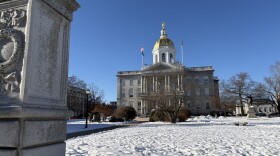The town of Hanover is close to powering its municipal energy needs completely through renewable energy, after completing the installation of its 1.72 megawatt ground-mounted solar array.
The array is one of the largest in the state and wraps up the second phase of a solar project that’s been in process over the past few years.
Hanover town facilities consume three megawatts of energy. This second array — along with a 720-kilowatt array and rooftop solar on town buildings — will provide about 97 percent of municipal electricity needs.
Dan Weeks is the vice president of business development at ReVision Energy, which installed the solar array. He says while Hanover has made progress, less than one percent of New Hampshire’s electricity comes from solar power.
“When we turn this on in a few days, we will be adding one percent solar additional solar capacity to the total installed capacity in the state of New Hampshire,” he said.
Julia Griffin, Hanover’s town manager, says the new array is important as Hanover attempts to transition to 100% renewable electricity by 2030. The town wants to lead by example, she says.
“We can’t very well browbeat others to get there if we haven’t gone there ourselves,” she said.
Transitioning municipal energy needs to renewables is the first part of Hanover’s four-step plan to meet its 2030 goal. Griffin says as a whole, Hanover consumes between 115 and 118 megawatts of electricity.
Other steps include solarizing and weatherizing as many homes and businesses as possible to reduce electricity consumption. By the end of 2020, 193 homes were solarized, and the town is working on getting to 250 by the end of this year.
“We have to connect different elements of our consumers to green power,” Griffin said.
The town also approved a community power plan this summer, which allows towns to purchase power in bulk on behalf of residents and business; and Griffin says the town wants to work with its largest users of electricity — like Dartmouth College and the Hanover Co-op — to consume more renewables through power purchase agreements.








